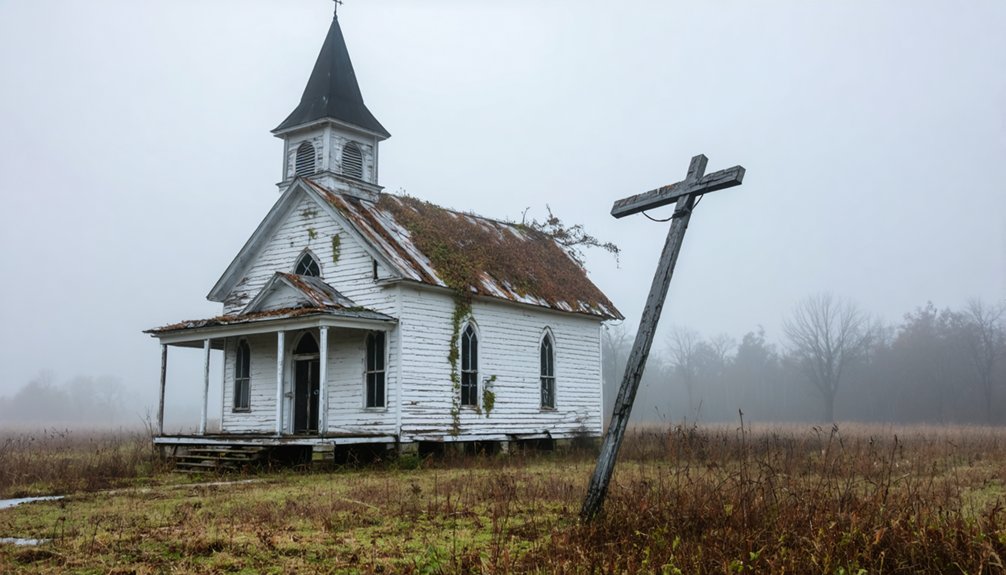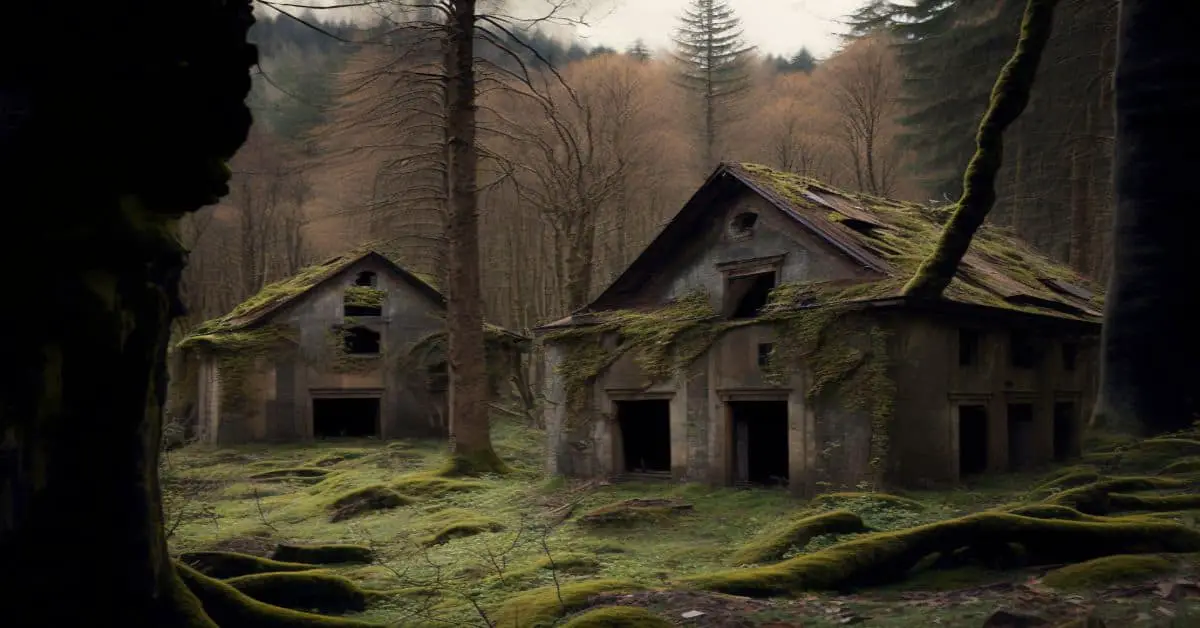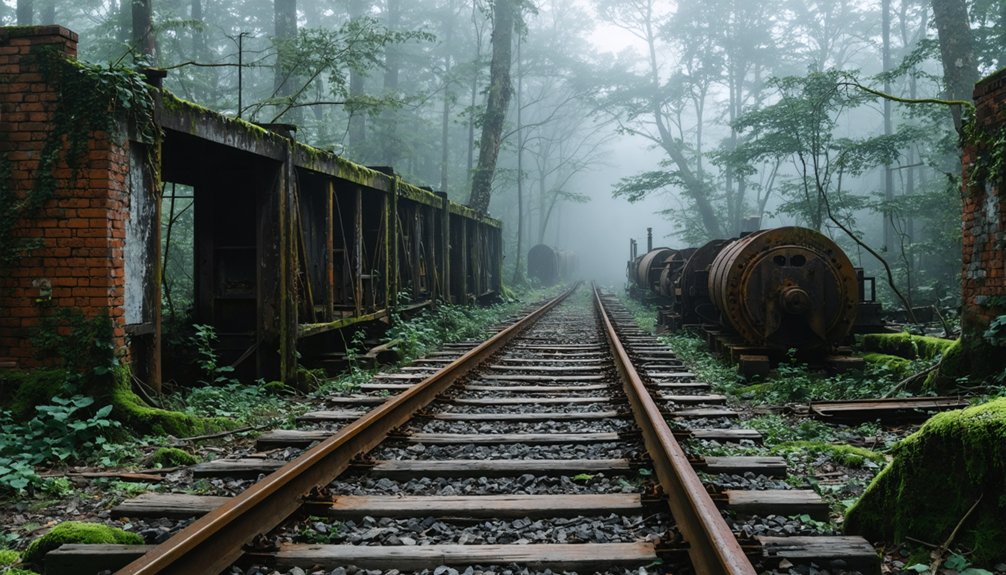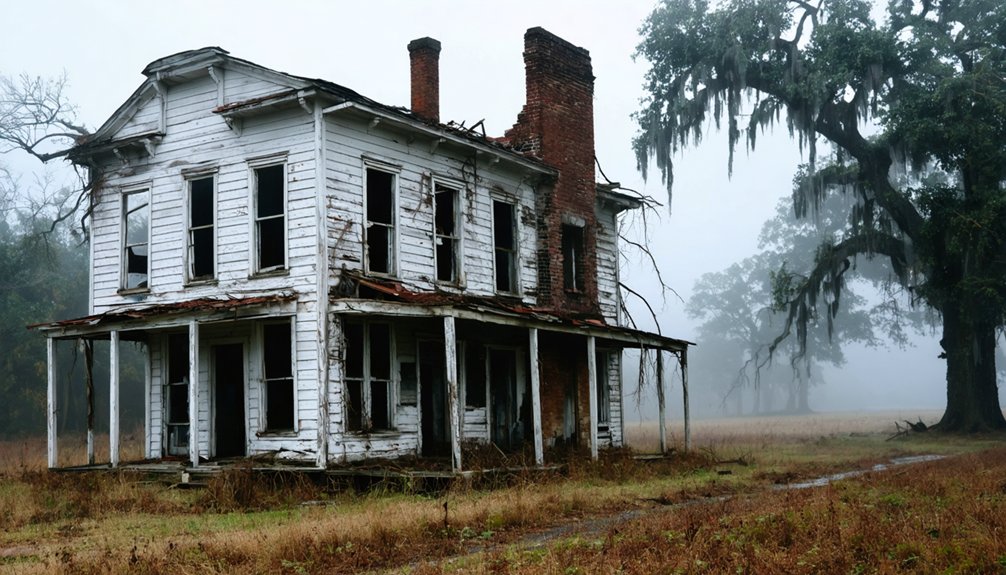You’ll find the ghost town of Burton deep beneath Lake Burton’s waters in northeast Georgia. Back in 1919, Georgia Power flooded this bustling mountain community to create a hydroelectric dam, forcing 65 families to leave their homes, businesses, and churches behind. Local divers still spot the submerged ruins of old buildings in the murky depths, and folks say they sometimes hear phantom church bells echoing across the water at night.
Key Takeaways
- Burton was a thriving mountain town in Rabun County, Georgia that was completely submerged in 1919 to create Lake Burton.
- Georgia Railway and Electric Company purchased the town in 1917, forcing approximately 65 families to relocate to higher ground.
- The town supported gold mining, lumber operations, and farming before its submersion beneath Lake Burton’s waters.
- Underwater ruins of Burton’s buildings, including churches and general stores, still exist beneath Lake Burton’s 2,775-acre surface.
- Local legends tell of mysterious specters and church bells heard from the submerged town, making it a true underwater ghost town.
The Birth of Powellsville and Early Settlers
While many Georgia towns sprang up during the gold rush era, Powellsville’s story began in the early 1800s when Scotch-Irish settlers established their community at the meeting point of Dicks Creek and the Tallulah River.
Y’all might wonder about those early settler lifestyles – they were hardy folk who built their lives around subsistence farming, logging, and milling in this fertile valley.
Those pioneers weren’t afraid of hard work, making their living off the land through farming, timber, and running the valley mills.
Without much formal early governance, the community organized itself around two churches – Baptist and Methodist – and a couple of general stores that served as the heart of local life. Like the Native Americans who inhabited Skull Shoals before European contact, the settlers found the land rich in resources.
Getting to nearby Clayton took a full day by horse-drawn wagon, but that isolation fostered a tight-knit community where neighbors looked after one another and built a thriving town that would later become Burton.
By 1900, the bustling community had grown into the second largest town in Rabun County, with over 200 residents calling it home.
From Gold Rush to Thriving Mountain Town
When gold was first discovered at the confluence of Moccasin Creek and the Tallulah River, Burton’s destiny as a mountain boomtown was set in motion. You’d find prospectors and their families flocking to this promising settlement, making it Rabun County’s first gold rush town.
But Burton’s folks showed their community resilience when the gold mining fever cooled. They didn’t just pack up and leave – they adapted. The town shifted to supporting corundum mines in Tate City, and the lumber industry took hold with the arrival of the narrow-gauge railroad. Like many entries in disambiguation pages, Burton’s history required careful navigation to distinguish it from other similarly named locations. Similar to how Cherokee miners gained valuable experience before moving west to California, the residents of Burton learned to diversify their economic activities.
Life Along the Tallulah River
Before the waters of Lake Burton claimed the town, you’d find life in Burton intimately tied to the mighty Tallulah River. Nestled at the confluence of Dicks Creek and the Tallulah, this mountain community thrived on the river’s bounty and power.
You could’ve watched the rush of clear mountain water powering local businesses, while wildlife flourished in the pristine river ecosystems. Helen Dortch Longstreet recognized the river’s importance and fought against damming to preserve its natural splendor.
The historical significance of the Tallulah River can’t be overstated – it wasn’t just a waterway, it was Burton’s lifeline. Y’all might’ve seen folks gathering at its banks, sharing stories while children splashed in the shallows. The town supported three general stores before its eventual purchase and flooding.
But progress had other plans. When the Georgia Railway and Electric Company set their sights on damming the river, they forever changed the landscape that generations of Burton folk had called home.
Industries That Shaped Burton
The bustling industries of Burton tell a tale as rich as the gold that first drew settlers to this mountain town. Y’all mightn’t believe it, but this little slice of North Georgia heaven was once a powerhouse of commerce and industry.
If you’d been around back then, you would’ve seen:
- Gold mining operations that brought fortune seekers from all corners, turning Burton into one of North Georgia’s first boomtowns.
- The mighty lumber industry, with Byrd-Mathews Lumber Company’s narrow-gauge railroad hauling timber down from the mountains.
- Hardworking farmers tending their corn and tobacco in the fertile river bottoms.
- Local fellas heading up to Tate City to work the corundum mines, with a few running moonshine operations on the side.
These industries kept Burton thriving until the waters of Lake Burton changed everything forever. The townspeople used nearby waterfall resources to keep their food cold before modern refrigeration came along. The Georgia Railway and Electric Company acquired the town shortly after World War I, forever changing its destiny.
A Community United: Churches, Schools, and Gatherings
Life in Burton revolved around its cherished community institutions, where folks gathered to worship, learn, and celebrate together. The local churches weren’t just places of worship – they were the heart and soul of Burton, hosting everything from weddings to charitable drives that strengthened community bonds.
Before the Gold Rush era, Burton’s early settlers established these vital gathering places that would shape the town’s social fabric for generations to come.
Y’all would’ve found the schools bustling with activity, where dedicated teachers shaped young minds with reading, writing, and ‘rithmetic.
Down at Burton’s schoolhouse, eager young’uns filled the halls while teachers poured their hearts into lessons day after day.
Beyond the classroom, cultural celebrations brought the town’s Scottish-Irish heritage to life through music, dance, and storytelling. Whether it was family reunions, outdoor sports, or seasonal festivals, Burton’s residents knew how to keep their traditions alive.
These gatherings weren’t just social events – they were the threads that wove the fabric of Burton’s tight-knit community. Sadly, these beloved spaces now rest at the bottom of Lake Burton’s waters, submerged when the town was sold to Georgia Power Company.
The Georgia Power Purchase
In 1917, Georgia Railway and Electric Company, now known as Georgia Power, made a historic purchase that would forever change Burton’s destiny.
The historical significance of this acquisition meant the end of over 100 years of community life, as the company needed the land to build a massive hydroelectric dam on the Tallulah River.
Y’all wouldn’t believe the impact this had on Burton’s folk. Here’s what happened:
- About 65 families had to pack up and move to higher ground
- The entire town, including businesses and churches, was abandoned
- Family cemeteries had to be carefully relocated
- Nearly 2,775 acres of land would soon be underwater
The purchase displaced around 200 people, making it one of the most significant community impacts in Rabun County’s history.
When they closed that dam in December 1919, Burton’s story sank beneath Lake Burton’s waters.
Beneath the Waters: Burton’s Final Days

You’d have been witness to one of Georgia’s most remarkable community relocations as Burton’s 65 families packed their belongings and headed for higher ground in 1919.
Local folks recall how neighbors helped each other load wagons with whatever they could carry, knowin’ their homes would soon disappear beneath Lake Burton’s waters.
The town’s final months saw a steady rise of water that swallowed up churches, stores, and homesteads – leavin’ behind an underwater legacy that still draws curiosity from folks who boat above the submerged ruins today.
Relocating an Entire Community
When the Georgia Railway and Electric Company purchased Burton in 1917, they set in motion one of the most poignant chapters in North Georgia’s history.
Y’all can’t imagine what it felt like for them 200 souls who’d to pack up their lives and leave the only home they’d known.
The community displacement hit folks hard, and here’s what happened to these proud mountain people:
- They received modest payments for their properties, barely enough to start fresh.
- Many scattered to higher ground, breaking up tight-knit family circles.
- Some had to leave their ancestors behind in graves that weren’t properly relocated.
- Their emotional impact ran deep as they watched their hometown prepare for flooding.
The whole thing was like watching your childhood home burn down, except they were flooding it on purpose.
Last Days Before Submersion
December 22, 1919 marked the beginning of Burton’s final chapter, as the massive dam gates closed and water started creeping up the valley floor.
You’d have seen families making their final memories, hauling what belongings they could save while watching the waters inch closer to their doorsteps.
Over nine months, the rising lake swallowed the town’s heart – the general store, churches, and homes that’d stood proud for generations.
Folks tell of the eerie sight as Burton’s submerged heritage disappeared beneath 2,775 acres of water.
Despite efforts to relocate graves, some say their kin still rest in the depths.
The old stone paths and steps remain underwater, silent witnesses to the mountain community that once thrived where fish now swim.
Legends and Legacy of a Submerged Town
Though Burton now rests beneath the waters of Lake Burton, its haunting legacy lives on through local folklore and eyewitness accounts. Y’all might hear stories passed down through generations about ghost stories and community folklore that’ll make your hair stand on end.
Some folks say they’ve witnessed:
- Mysterious specters rising from the lake at night, dancin’ like moonlit shadows
- Church bells echoing across the water on quiet evenings, though the steeples are long gone
- Divers spotting old buildings and remnants of the town in the murky depths
- Strange shadows moving near the old cemetery sites along the shore
These tales ain’t just stories – they’re reminders of the sacrifices made by Burton’s families who gave up their homes for progress.
The town might be underwater, but its spirit sure ain’t dampened.
Frequently Asked Questions
What Happened to the Residents’ Pets During the Town’s Flooding?
You’d be amazed, but there’s no record of pet rescue or animal memorials. While folks had plenty of time to move their pets, history ain’t tellin’ what exactly happened to them critters.
Can Visitors See Any Remains of Burton During Periods of Drought?
You can’t reliably spot abandoned structures during droughts, as there’s no documented evidence of remains becoming visible. Even when drought impacts water levels, the town’s remnants stay deep underwater.
Were There Any Holdouts Who Refused to Leave Their Homes?
While holdout stories stir the imagination, y’all won’t find records of folks refusing to leave. Historical documents show all 65 families sold their hometown memories and moved before Lake Burton’s waters rose.
Did Any Artifacts From Burton Wash up on Lake Burton’s Shores?
You won’t find confirmed artifact discoveries on Lake Burton’s shores. Despite folks’ lake exploration over the years, there’s no official record of items from old Burton washing up anywhere.
What Was the Total Compensation Amount Paid to Displaced Burton Families?
While y’all might want exact figures, historical records don’t reveal the total displacement impact or financial assistance amounts. Burton families received only “modest payments” when selling their properties during 1917-1919.
References
- https://rabunhistory.org/articles/burton-the-town-under-the-lake/
- https://www.hauntsandhollows.com/the-lost-town-of-burton/
- https://en.wikipedia.org/wiki/Burton
- https://www.creepypasta.com/lake-burton-story/
- https://lakeburtonretreat.com/2016/10/12/the-town-of-burton/
- https://yesterdaysamerica.com/history-submerged-georgias-drowned-towns/
- http://byeby2day.blogspot.com/2013/08/burton-ga.html
- https://driftwoodchronicle.wordpress.com/2016/10/11/gone-with-the-wind-ghost-towns-of-georgia/
- https://vanishinggeorgia.com/tag/georgia-ghost-towns/page/2/
- https://en.wikipedia.org/wiki/List_of_ghost_towns_in_Georgia_(U.S._state)



